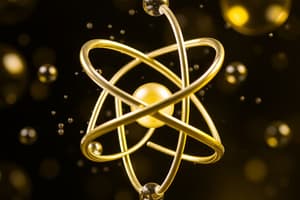Podcast
Questions and Answers
How many valence electrons are present in K2S?
How many valence electrons are present in K2S?
- 16
- 4
- 2
- 8 (correct)
What happens in an exothermic reaction?
What happens in an exothermic reaction?
- Chemical bonds are broken without energy change
- The temperature remains constant
- Energy is absorbed from the surroundings
- Energy is released into the surroundings (correct)
What type of bond is primarily formed between atoms with electron configurations 1s²2s² and 1s²2s²2p⁶3s²3p⁶?
What type of bond is primarily formed between atoms with electron configurations 1s²2s² and 1s²2s²2p⁶3s²3p⁶?
- Ionic bond (correct)
- Metallic bond
- Covalent bond
- Hydrogen bond
Which molecular geometry corresponds to the molecule SO3?
Which molecular geometry corresponds to the molecule SO3?
Which statement about isotopes is true?
Which statement about isotopes is true?
What is the shared electron count between the carbon atoms in H2-C=C-H2?
What is the shared electron count between the carbon atoms in H2-C=C-H2?
How many electrons can the fifth principal energy level hold when completely filled?
How many electrons can the fifth principal energy level hold when completely filled?
What is an indication of a chemical change?
What is an indication of a chemical change?
Which statement about electronegativity is correct?
Which statement about electronegativity is correct?
What is the molecular shape of water (H2O)?
What is the molecular shape of water (H2O)?
When an atom loses an electron, what charge does it become?
When an atom loses an electron, what charge does it become?
What type of forces hold AgNO3 together?
What type of forces hold AgNO3 together?
What describes the major portion of an atom's volume?
What describes the major portion of an atom's volume?
Which of the following compounds is considered an ionic compound?
Which of the following compounds is considered an ionic compound?
What is the main factor influencing the shape of a molecule?
What is the main factor influencing the shape of a molecule?
Which of the following describes electron spin in orbitals?
Which of the following describes electron spin in orbitals?
Which of the following segments on the heating curve represents liquid phase?
Which of the following segments on the heating curve represents liquid phase?
What occurs when the pressure of a substance is increased at a given temperature?
What occurs when the pressure of a substance is increased at a given temperature?
What happens to electrons when they move to a higher energy level?
What happens to electrons when they move to a higher energy level?
What is the strongest type of Van der Waals force?
What is the strongest type of Van der Waals force?
In which phase change are intermolecular forces primarily overcome?
In which phase change are intermolecular forces primarily overcome?
What is the oxidation state of mercury in HgS?
What is the oxidation state of mercury in HgS?
Which chemical bond occurs specifically between hydrogen and electronegative atoms like O, N, or F?
Which chemical bond occurs specifically between hydrogen and electronegative atoms like O, N, or F?
What happens at the critical point in a substance's phase diagram?
What happens at the critical point in a substance's phase diagram?
What charge do halogens in Group 17 typically gain when they form ions?
What charge do halogens in Group 17 typically gain when they form ions?
Which suffix is commonly used in naming ionic compounds when the nonmetal is the second listed element?
Which suffix is commonly used in naming ionic compounds when the nonmetal is the second listed element?
What is the correct total number of Y atoms in a compound that has the formula X3Y and contains 15 X atoms?
What is the correct total number of Y atoms in a compound that has the formula X3Y and contains 15 X atoms?
Which of the following compounds is named using the Stock System?
Which of the following compounds is named using the Stock System?
Which of the following describes binary molecular compounds?
Which of the following describes binary molecular compounds?
How do chlorate and chlorite ions differ from each other?
How do chlorate and chlorite ions differ from each other?
When testing the odor of fumes, what is the correct method?
When testing the odor of fumes, what is the correct method?
In a neutral compound formed from ions, what must the total oxidation state equal?
In a neutral compound formed from ions, what must the total oxidation state equal?
What is the weighted atomic mass of Bromine based on its isotopes X-79 and X-81?
What is the weighted atomic mass of Bromine based on its isotopes X-79 and X-81?
Which element has the highest electronegativity?
Which element has the highest electronegativity?
What characterizes the elements in Group 15 as you move down the group?
What characterizes the elements in Group 15 as you move down the group?
Which of the following statements about nonmetals is true?
Which of the following statements about nonmetals is true?
Which element is known to have the least tendency to lose electrons in Period 4?
Which element is known to have the least tendency to lose electrons in Period 4?
Which of the following correctly describes the grouping of elements on the periodic table?
Which of the following correctly describes the grouping of elements on the periodic table?
What determines the organization of the periodic table?
What determines the organization of the periodic table?
Which statement about electron configurations is true for the element in Period 5?
Which statement about electron configurations is true for the element in Period 5?
Flashcards
Endothermic Reaction
Endothermic Reaction
A chemical reaction where energy is absorbed from the surroundings, causing the temperature to decrease.
Exothermic Reaction
Exothermic Reaction
A chemical reaction where energy is released into the surroundings, causing the temperature to increase.
Elements
Elements
Substances that cannot be broken down into simpler substances by ordinary chemical means.
Physical Changes
Physical Changes
Signup and view all the flashcards
Chemical Changes
Chemical Changes
Signup and view all the flashcards
Atomic Composition
Atomic Composition
Signup and view all the flashcards
Isotopes
Isotopes
Signup and view all the flashcards
Electron Configuration
Electron Configuration
Signup and view all the flashcards
Weighted Atomic Mass
Weighted Atomic Mass
Signup and view all the flashcards
Hund's Rule
Hund's Rule
Signup and view all the flashcards
Atomic Orbital
Atomic Orbital
Signup and view all the flashcards
Nucleus
Nucleus
Signup and view all the flashcards
Group (Periodic Table)
Group (Periodic Table)
Signup and view all the flashcards
Electronegativity Trend
Electronegativity Trend
Signup and view all the flashcards
Group 15 Trend
Group 15 Trend
Signup and view all the flashcards
Valence Electrons
Valence Electrons
Signup and view all the flashcards
Phase Diagram
Phase Diagram
Signup and view all the flashcards
Triple Point
Triple Point
Signup and view all the flashcards
Critical Point
Critical Point
Signup and view all the flashcards
Sublimation
Sublimation
Signup and view all the flashcards
Evaporation
Evaporation
Signup and view all the flashcards
Hydrogen Bonding
Hydrogen Bonding
Signup and view all the flashcards
Intermolecular Forces
Intermolecular Forces
Signup and view all the flashcards
Intramolecular Forces
Intramolecular Forces
Signup and view all the flashcards
Metal-Nonmetal Reaction
Metal-Nonmetal Reaction
Signup and view all the flashcards
Electronegativity
Electronegativity
Signup and view all the flashcards
Molecular Shape
Molecular Shape
Signup and view all the flashcards
Ionic Compound
Ionic Compound
Signup and view all the flashcards
Shared Electrons
Shared Electrons
Signup and view all the flashcards
Stability
Stability
Signup and view all the flashcards
Chemical Formula Definition
Chemical Formula Definition
Signup and view all the flashcards
What is a binary molecular compound?
What is a binary molecular compound?
Signup and view all the flashcards
What is the stock system for naming?
What is the stock system for naming?
Signup and view all the flashcards
Neutral Compound Oxidation Number
Neutral Compound Oxidation Number
Signup and view all the flashcards
Compare Chlorate and Chlorite
Compare Chlorate and Chlorite
Signup and view all the flashcards
What are polyatomic ions?
What are polyatomic ions?
Signup and view all the flashcards
What is oxidation number?
What is oxidation number?
Signup and view all the flashcards
When do we use the suffix 'ide'?
When do we use the suffix 'ide'?
Signup and view all the flashcards
Study Notes
Exam Study Guide
- The study guide comprehensively represents the exam, though minor changes may occur.
- Successful completion of the guide ensures exam success.
- Resources include: Physical/Chemical Notepacket, Atomic Structure Notepacket, Periodicity Notepacket, Bonding Notepacket, Phase/IMF Notepacket, Nomenclature Notepacket, and Supplementary Packets.
Chemical Reactions
- Endothermic Reactions: Absorb energy.
- Exothermic Reactions: Release energy.
Elements and Substances
- Elements: Substances that can't be decomposed by chemical means.
- Examples of physical changes (matter): State change, cutting, crushing, dissolving.
- Examples of chemical changes (matter): Decomposition, rusting, corrosion, combustion.
Atomic Structure
- Atoms of the same element have the same number of protons.
- Chlorine-35 isotope composition: 17 protons, 18 neutrons, 17 electrons.
Energy Levels and Sublevels
- 5d¹⁰: Energy level 5, sublevel d, 10 electrons in orbitals.
Atomic Structure - General
- The major portion of an atom's volume is empty space (electron cloud).
Atomic Number and Ions
- Atomic number is equal to the number of protons.
- Losing an electron creates a positively charged ion.
Chemical Bonding
- Electronegativity: Increases across a period (except for the noble gases), and decreases down a group.
- Metals vs. nonmetals The least ionic character is found with nonmetals.
Periodicity
- Elements in the same group share similar chemical properties.
- Fluorine (F) is the most active nonmetal.
Electron Configuration
- Valence electrons: Determine the reactivity of an element.
- Hund's rule: Each orbital is occupied by one electron before any is occupied by a second.
- Orbitals with equal energy are singly populated with electrons before filling.
Orbital
- Each orbital can hold a maximum of 2 electrons.
Periodic Trends
- Chemical properties change across a period (row).
- Electron behavior in different periods: Properties such as ionization energy and tendency to lose electrons change across a period (row).
Chemical Bonding
- Ionic bonds: Electrostatic attraction between oppositely charged ions.
- Metallic: Atoms held together in a metal by metallic bonding.
- Covalent bonds: Electrons are shared.
Studying That Suits You
Use AI to generate personalized quizzes and flashcards to suit your learning preferences.




